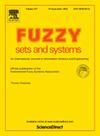基于参数化模糊β覆盖关系的模糊粗糙集模型及其在三向决策和属性约简中的应用
IF 2.7
1区 数学
Q2 COMPUTER SCIENCE, THEORY & METHODS
引用次数: 0
摘要
在现有的模糊β-覆盖粗糙集(f - β- crs)模型研究中,往往要求每个覆盖的参数β相等,这严重制约了模型在应用中的灵活性和实用效率。此外,现有的模糊β-邻域算子(f - β- nos)由于大多不能满足自反性或对称性,表达能力有限。因此,有必要研究一种更灵活、更通用的模型。为了解决这一问题,本文在一个新的变尺度模糊β覆盖近似空间(VSFβ-CAS)中构建了一些新的Fβ-NOs和Fβ-CRS模型,并探讨了它们的性质。首先,基于重叠函数和分组函数,在VSFβ-CAS中提出了四种满足自反性和对称性的Fβ-NOs,包括参数化模糊β-邻域和参数化模糊互补β-邻域。论证了它们的性质,证明它们都符合模糊β-覆盖关系的结构要求。在此理论基础上,进一步构建了具有上近似-下近似关系的4个Fβ-CRS模型。讨论了模型的基本性质和模型之间的相互关系。最后,在构建模型的基础上,对样本和属性分别设计三向决策和属性约简实验。首先,我们将提出的四种模型应用于三方决策任务:我们定义了模糊和清晰的三方区域,并使用六种测量方法在公共数据集上进行了比较实验。同时,引入模糊相关函数和模糊复合函数,开发了一些变尺度属性约简算法。深入分析了不同β值和函数配置对实验结果的影响,并在公开数据集上与现有模型进行了对比实验。实验结果表明,我们的模型不仅在处理样本和属性相关问题上都表现出了优势和合理性,而且表现出了更高的灵活性,进一步验证了所提模型强大的泛化能力。本文章由计算机程序翻译,如有差异,请以英文原文为准。
Parameterized fuzzy β-covering relations-based fuzzy rough set models and their applications to three-way decision and attribute reduction
In the existing research on fuzzy β-covering rough set (Fβ-CRS) models, it is often required that the parameter β of each covering be equal, which seriously restricts the flexibility and practical efficiency of the model in applications. Additionally, the existing fuzzy β-neighborhood operators (Fβ-NOs) have limited expressive power, as most of them fail to satisfy reflexivity or symmetry. Therefore, it is necessary to study a more flexible and general model. To address this issue, this paper constructs some novel Fβ-NOs and Fβ-CRS models within a new variable-scale fuzzy β-covering approximation space (VSFβ-CAS), and explores their properties. First, based on overlap functions and grouping functions, four types of Fβ-NOs satisfying reflexivity and symmetry are proposed in VSFβ-CAS, which include parameterized fuzzy β-neighborhoods and parameterized fuzzy complementary β-neighborhoods. Their properties are demonstrated and it is proven that all conform to the structural requirements of fuzzy β-covering relations. On this theoretical basis, four Fβ-CRS models with upper approximation-inclusion lower approximation relations are further constructed. The basic properties of the models and the interrelationships among different models are discussed. Finally, based on the four constructed models, we designed experiments for both samples and attributes, i.e., three-way decision and attribute reduction. First, we applied the four proposed models to three-way decision tasks: we defined both fuzzy and crisp three-way regions, and performed comparative experiments on public datasets using six measurements. Meanwhile, we introduced fuzzy dependency functions and fuzzy composite functions, and developed some variable-scale attribute reduction algorithms. We then conducted in-depth analyses on how different β values and function configurations affect experimental results, and carried out comparative experiments with existing models on public datasets. The experimental results indicate that our models not only demonstrate advantages and rationality in addressing both sample and attribute-related issues, but also exhibit higher flexibility—further validating the strong generalization ability of the proposed models.
求助全文
通过发布文献求助,成功后即可免费获取论文全文。
去求助
来源期刊

Fuzzy Sets and Systems
数学-计算机:理论方法
CiteScore
6.50
自引率
17.90%
发文量
321
审稿时长
6.1 months
期刊介绍:
Since its launching in 1978, the journal Fuzzy Sets and Systems has been devoted to the international advancement of the theory and application of fuzzy sets and systems. The theory of fuzzy sets now encompasses a well organized corpus of basic notions including (and not restricted to) aggregation operations, a generalized theory of relations, specific measures of information content, a calculus of fuzzy numbers. Fuzzy sets are also the cornerstone of a non-additive uncertainty theory, namely possibility theory, and of a versatile tool for both linguistic and numerical modeling: fuzzy rule-based systems. Numerous works now combine fuzzy concepts with other scientific disciplines as well as modern technologies.
In mathematics fuzzy sets have triggered new research topics in connection with category theory, topology, algebra, analysis. Fuzzy sets are also part of a recent trend in the study of generalized measures and integrals, and are combined with statistical methods. Furthermore, fuzzy sets have strong logical underpinnings in the tradition of many-valued logics.
 求助内容:
求助内容: 应助结果提醒方式:
应助结果提醒方式:


